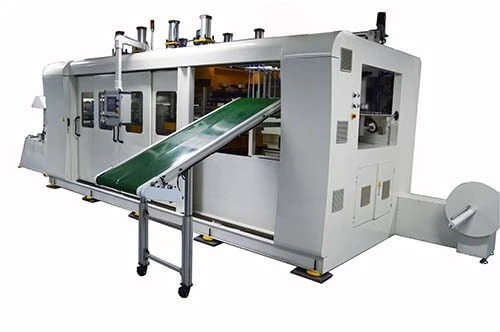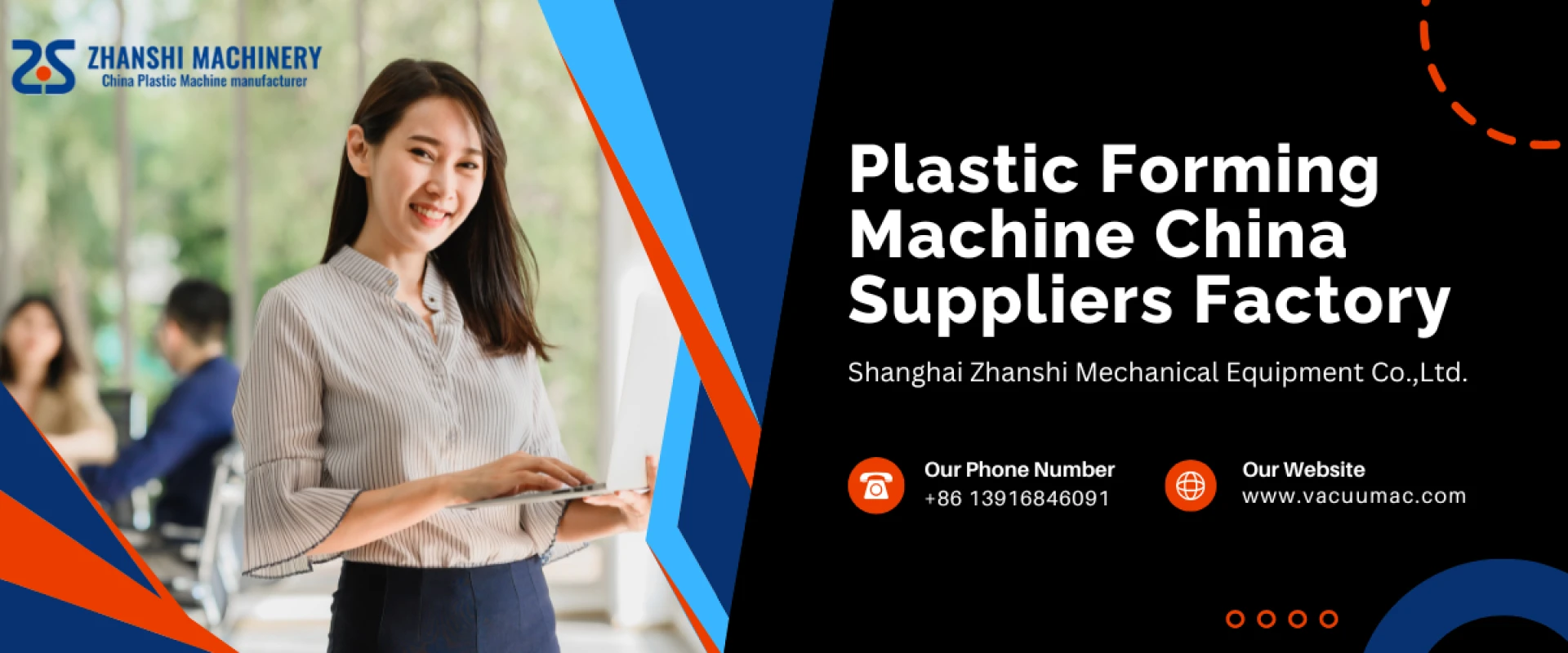In the ever-evolving world of plastic manufacturing, efficiency and cost-effectiveness have become two of the most vital performance indicators for success. Businesses today are under constant pressure to meet higher production demands while maintaining stringent quality standards and minimizing operational costs. One machine that has proven to be a game-changer in achieving these goals is the Vacuum Forming Machine.
At Shanghai Zhanshi Mechanical Equipment Co., Ltd., we specialize in designing and manufacturing high-performance Vacuum Forming Machines that deliver unmatched productivity, reliability, and precision. Whether you’re producing packaging trays, automotive parts, or custom plastic enclosures, vacuum forming technology offers a smarter, more sustainable, and cost-efficient manufacturing solution.
Understanding the Vacuum Forming Process
A vacuum forming machine is a simplified version of thermoforming—a process where a thermoplastic sheet is heated until pliable, then shaped over a mold using vacuum pressure. Once the plastic conforms to the mold’s shape, it’s cooled and trimmed to create the final product.
The process can be broken down into key stages:
- Sheet Clamping: The plastic sheet is clamped securely in the machine’s frame.
- Heating: Infrared or ceramic heaters soften the sheet uniformly.
- Forming: A vacuum pump removes air between the mold and the softened sheet, pulling the plastic tightly over the mold.
- Cooling: The formed plastic part is allowed to cool and harden.
- Trimming and Finishing: The final product is trimmed and ready for packaging or assembly.
This straightforward process is highly versatile and suitable for producing a wide variety of plastic products, from simple packaging trays to complex industrial components.
Why Manufacturers Choose Vacuum Forming Machines
The Vacuum Forming Machine has become a popular choice for industries due to its versatility, speed, and cost-effectiveness. Here’s why it stands out:
a. Cost-Effective Production
Vacuum forming requires less tooling investment compared to injection molding or blow molding. This makes it ideal for both low and high-volume production runs, reducing upfront costs significantly.
b. Fast Turnaround Time
Since tooling is simpler and faster to produce, manufacturers can bring new products to market quickly—perfect for industries that require frequent design changes or customization.
c. Design Flexibility
Vacuum forming allows manufacturers to create detailed and complex shapes with varying thicknesses, offering unmatched design freedom for packaging, automotive, and consumer goods.
d. Material Efficiency
The process optimizes the use of thermoplastic sheets, minimizing material waste during forming and trimming, which directly lowers production costs.
e. Wide Material Compatibility
A Vacuum Forming Machine can work with numerous materials such as ABS, PET, HIPS, PVC, and Polycarbonate, making it adaptable for different industries and applications.
How a Vacuum Forming Machine Works
A Vacuum Forming Machine operates through a combination of heat, vacuum pressure, and molding precision. Modern machines incorporate advanced control systems and automation features to ensure consistent quality and efficiency.
Here’s a typical operational flow:
- Material Loading: Plastic sheets are automatically fed into the machine.
- Preheating Stage: Heating elements warm the sheet evenly to the right forming temperature.
- Mold Placement: The mold moves into position under the softened sheet.
- Vacuum Application: Air is evacuated, causing the sheet to mold tightly to the desired shape.
- Cooling and Ejection: The formed part cools and is ejected automatically for further processing.
At Shanghai Zhanshi Mechanical Equipment Co., Ltd., our vacuum forming systems are designed with servo-driven mechanisms, intelligent temperature controls, and automated trimming systems—all of which ensure precision, repeatability, and reduced labor requirements.
Maximizing Efficiency with a Vacuum Forming Machine
Efficiency isn’t just about speed—it’s about producing more with fewer resources, less energy, and minimal waste. Let’s explore how to achieve maximum efficiency from your Vacuum Forming Machine.
a. Optimize Heating Settings
Precise heating is critical for consistent forming results. Using zoned infrared heaters and temperature sensors ensures uniform sheet heating, which reduces defective parts and improves yield.
b. Use Automated Sheet Feeding and Stacking Systems
Automation eliminates manual handling, reducing operator fatigue and human errors. Automatic feeding and stacking improve production flow and ensure a continuous cycle, thereby maximizing output.
c. Maintain Proper Mold Design
Efficient mold design minimizes air entrapment, reduces cycle times, and improves forming precision. Using molds with optimized venting and proper cooling channels enhances the efficiency of the entire forming process.
d. Implement Smart Control Systems
Modern machines equipped with PLC or touchscreen HMI controls allow operators to adjust parameters quickly, monitor performance, and identify issues instantly. This minimizes downtime and boosts productivity.
e. Schedule Preventive Maintenance
Regular maintenance—like cleaning vacuum lines, lubricating moving parts, and checking seals—ensures your machine runs smoothly and avoids costly breakdowns.
Cutting Costs with Vacuum Forming Technology
Reducing production costs while maintaining quality is a top priority for every manufacturer. The Vacuum Forming Machine naturally supports cost-saving initiatives through its design and operation.
a. Lower Tooling Costs
Molds for vacuum forming are simpler and less expensive to produce, especially when using materials like aluminum or epoxy. This dramatically reduces upfront investment costs compared to injection molds.
b. Reduced Material Waste
The process uses just enough material for each part, minimizing waste. Any excess sheet trimmings can often be recycled and reused.
c. Energy Efficiency
Modern machines use energy-efficient heaters and variable-speed vacuum pumps, which cut down on power consumption without sacrificing performance.
d. Minimal Labor Requirements
Automation reduces the need for multiple operators. With only one or two technicians managing the process, labor costs drop while maintaining high productivity.
e. Shorter Production Cycles
Faster cycle times mean more parts produced per shift, spreading overhead costs across a higher output—an essential factor in achieving cost efficiency.
Applications of Vacuum Forming Machines
The versatility of vacuum forming machine makes it suitable for a wide range of applications, including:
- Packaging Industry: Food trays, blister packs, and clamshell containers.
- Automotive Sector: Dashboards, door panels, and protective covers.
- Medical Devices: Sterile packaging and equipment trays.
- Consumer Products: Bath panels, refrigerator liners, and enclosures.
- Construction and Industrial Uses: Machine guards, panels, and insulation covers.
With such diverse use cases, it’s easy to see why the Vacuum Forming Machine is considered one of the most adaptable tools in modern manufacturing.
Material Selection for Vacuum Forming
Selecting the right thermoplastic material is key to achieving desired product characteristics. Here are some commonly used materials:
- ABS (Acrylonitrile Butadiene Styrene): Durable, impact-resistant, ideal for automotive and appliance parts.
- HIPS (High Impact Polystyrene): Lightweight and cost-effective, great for packaging applications.
- PET/PETG (Polyethylene Terephthalate): Transparent and recyclable, often used for food packaging.
- PVC (Polyvinyl Chloride): Excellent for durable and chemically resistant components.
- Polycarbonate: High-strength material used for protective equipment and machinery covers.
Understanding each material’s heating and forming behavior helps manufacturers reduce waste and achieve better quality at lower cost.
Sustainability and Eco-Friendly Manufacturing
Sustainability is no longer optional—it’s an expectation. Fortunately, vacuum forming contributes positively to environmentally responsible production.
- Recyclable Materials: Many plastics used in vacuum forming are recyclable and can be reused in future production.
- Reduced Waste: Optimized sheet usage and trimming recovery minimize scrap.
- Energy Efficiency: Modern heating systems consume less energy.
- Lightweight Products: Reduce shipping costs and carbon footprint.
By adopting Vacuum Forming Machines from Shanghai Zhanshi Mechanical Equipment Co., Ltd., manufacturers can meet sustainability goals without sacrificing productivity.
Maintenance and Best Practices
To ensure optimal performance, follow these maintenance practices:
- Regular Cleaning: Keep heating elements and vacuum lines free of dust and residue.
- Lubrication: Maintain moving components for smooth operation.
- Seal Inspection: Check gaskets and seals for leaks to maintain vacuum integrity.
- Calibration: Periodically calibrate temperature and pressure sensors.
- Operator Training: Well-trained operators reduce errors and improve efficiency.
Preventive care leads to fewer breakdowns and maximizes machine lifespan—further cutting operational costs.
Future Trends in Vacuum Forming Technology
The vacuum forming industry continues to evolve rapidly. Here are some trends shaping its future:
- Smart Monitoring Systems: IoT integration for real-time performance data.
- AI-Powered Quality Control: Automatic defect detection and predictive maintenance.
- Advanced Material Compatibility: Greater use of biodegradable and recyclable plastics.
- Energy Optimization: More efficient heating systems and vacuum pumps.
- Modular Machine Designs: Easier customization for diverse production lines.
Staying ahead of these trends ensures that manufacturers remain competitive and future-ready.
Why Choose Shanghai Zhanshi Mechanical Equipment Co., Ltd.
At Shanghai Zhanshi Mechanical Equipment Co., Ltd., we’re dedicated to helping manufacturers achieve the perfect balance of quality, efficiency, and economy. Our Vacuum Forming Machines are designed with:
- Advanced servo-driven control systems
- Precision infrared heating technology
- Fully automated loading and stacking systems
- Energy-efficient operation
- Strong after-sales support and technical training
Whether you are a small business scaling up or a large industrial producer, we have customized solutions to fit your exact manufacturing needs.
To sum up, investing in a Vacuum Forming Machine is not just about upgrading equipment—it’s about transforming your entire production ecosystem. With the right machine, manufacturers can achieve higher output, reduce costs, improve consistency, and embrace sustainable production practices.
The combination of automation, precision, and versatility makes vacuum forming an invaluable asset across multiple industries. By partnering with Shanghai Zhanshi Mechanical Equipment Co., Ltd., you gain access to innovative technology, expert engineering, and dependable support that ensure long-term success.
If you’re ready to take your production efficiency to the next level while cutting operational expenses, it’s time to make the smart move—invest in a high-quality Vacuum Forming Machine today.
Frequently Asked Questions (FAQs)
1. What materials can be used in a Vacuum Forming Machine?
Common materials include ABS, HIPS, PET, PVC, and Polycarbonate, each suited for specific product requirements such as durability, clarity, or flexibility.
2. How can vacuum forming reduce production costs?
It lowers costs by reducing tooling expenses, minimizing material waste, and enabling faster cycle times with fewer labor requirements.
3. Is vacuum forming suitable for large-scale production?
Yes. Modern Vacuum Forming Machines are fully automated and capable of high-volume, continuous production with consistent quality.
4. What maintenance is required for these machines?
Regular cleaning, calibration, and inspection of heating and vacuum systems ensure reliable performance and extend machine life.
5. Why should I choose Shanghai Zhanshi Mechanical Equipment Co., Ltd.?
We offer state-of-the-art Vacuum Forming Machines that combine efficiency, durability, and innovation, supported by excellent technical assistance and after-sales service.





